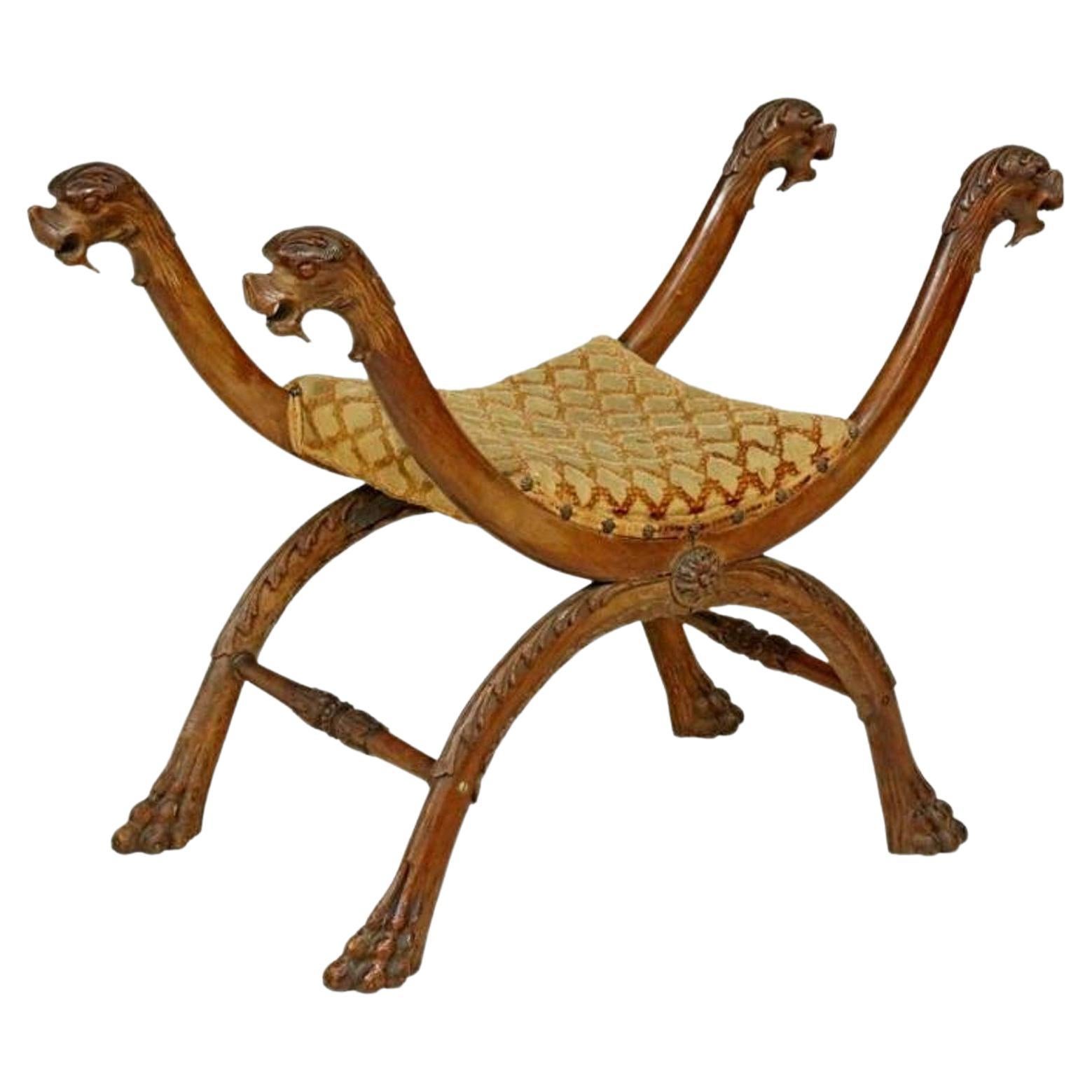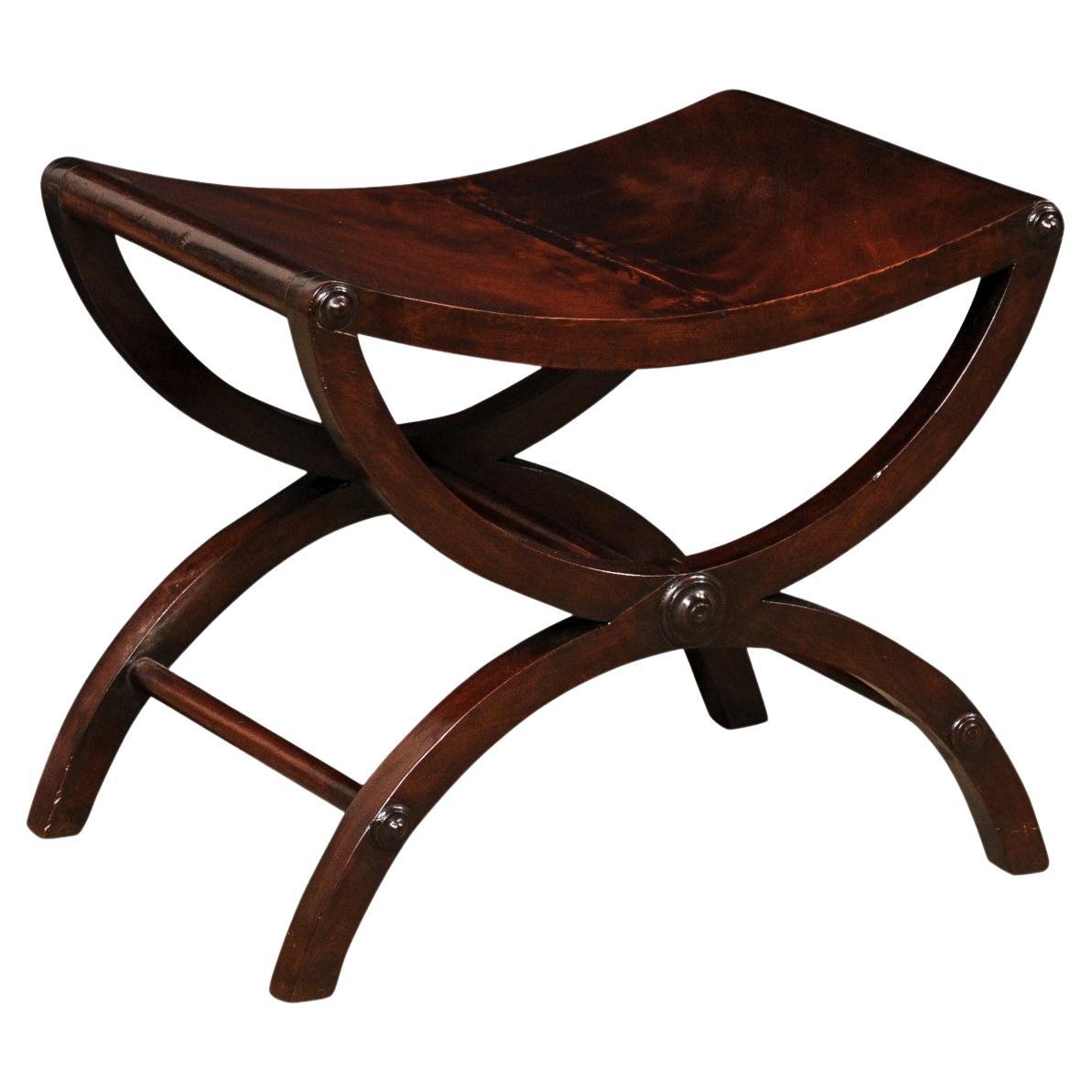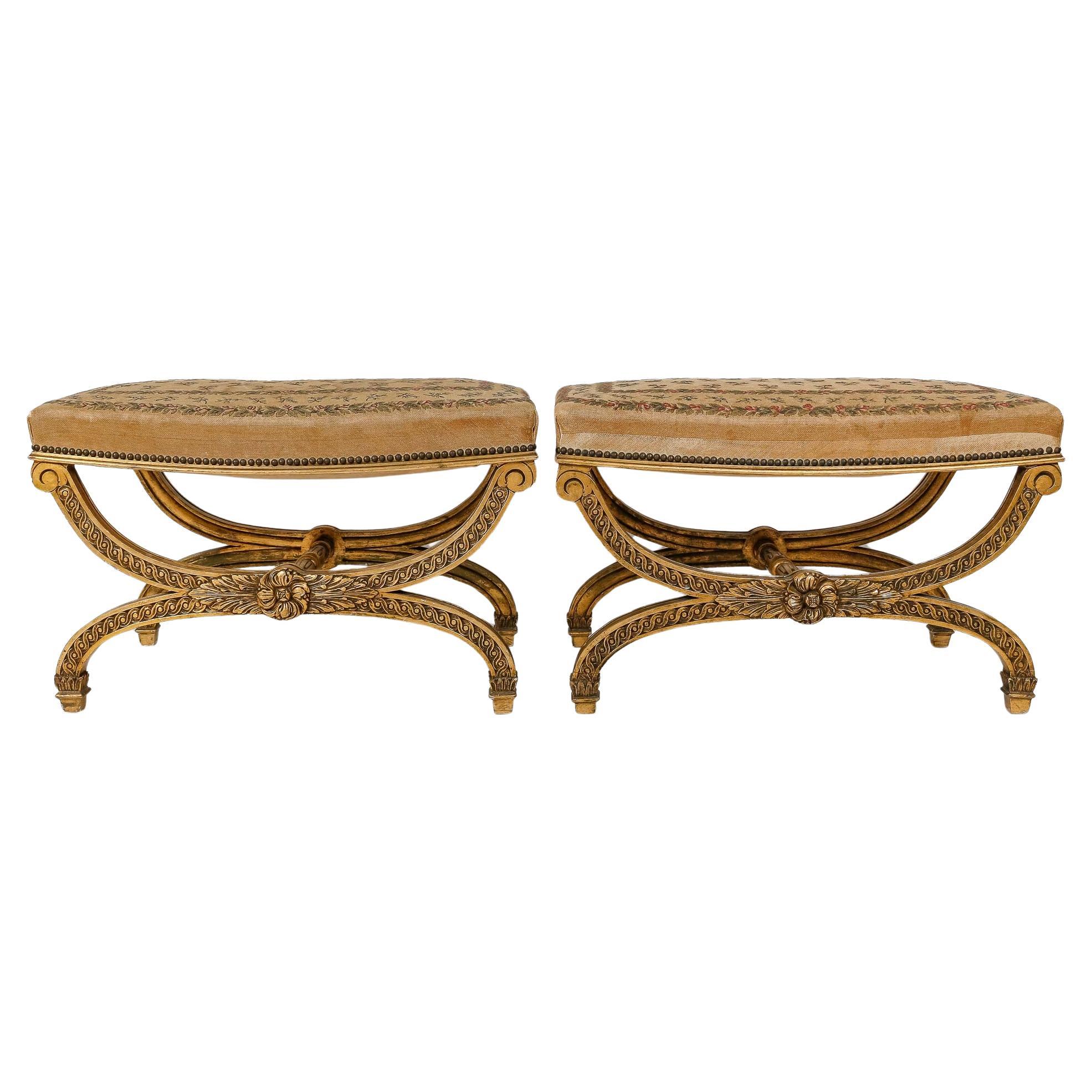Items Similar to Pair of 19th century Italian Polychrome and Parcel-Gilt Curule Stools
Want more images or videos?
Request additional images or videos from the seller
1 of 21
Pair of 19th century Italian Polychrome and Parcel-Gilt Curule Stools
About the Item
Pair of 19th century Italian painted and gilt wood curule stools with richly carved medallions, resting on scrolled feet with cross stretchers.
Uphlostered in original timeworn Italian fabric.
- Dimensions:Height: 15 in (38.1 cm)Width: 21.75 in (55.25 cm)Depth: 16 in (40.64 cm)Seat Height: 15 in (38.1 cm)
- Sold As:Set of 2
- Materials and Techniques:
- Place of Origin:
- Period:
- Date of Manufacture:19th century
- Condition:Wear consistent with age and use. Minor fading. Very sturdy pair of antique stools in original worn condition with some old chips and worn fabric what need to be replace if you want.
- Seller Location:Charleston, SC
- Reference Number:
About the Seller
4.9
Vetted Seller
These experienced sellers undergo a comprehensive evaluation by our team of in-house experts.
Established in 1992
1stDibs seller since 2013
367 sales on 1stDibs
Typical response time: 19 hours
- ShippingRetrieving quote...Ships From: Charleston, SC
- Return PolicyThis item cannot be returned.
More From This SellerView All
- 19th Century Italian Gilt Wood and Iron ChandelierLocated in Charleston, SCEarly 19th century Italian Gilt Wood and Iron Chandelier with six arms, three tiers with crystal drops, rosettes, swags and patinated pressed tole medallions. Electrified for USA st...Category
Antique 19th Century Italian Chandeliers and Pendants
MaterialsCrystal, Iron, Metal
- Pair of 19th century Italian Painted FootstoolsLocated in Charleston, SCPair of 19th century Italian painted Footstools standing on cabriole legs with richly foliate carvings and gilt wood decorations.Category
Antique 19th Century Italian Footstools
MaterialsFabric, Giltwood, Paint
- Pair of 19th Century Italian Altar CandelabrasLocated in Charleston, SCPair of 19th century Italian Altar candelabras Very unusual, in patinated silver gilt.Category
Antique 19th Century Italian Candelabras
MaterialsIron, Silver Leaf
- Pair of 19th century Italian Bust Stands/PedestalsLocated in Charleston, SCPair of 19th century bust stands/pedestals/columns - painted, decorative paneled with molded tops and sides in octagon shape. Painted in decorative marble trompe l'oeil effect with g...Category
Antique 19th Century Italian Pedestals
MaterialsGold
- Pair of 19th Century Swedish Country ChairsLocated in Charleston, SCAlmost a pair of 19th century Swedish country chairs. Very slight difference of size with great patina and re-upholstered now in linen.Category
Antique 19th Century Swedish Side Chairs
MaterialsLinen, Wood
- Pair of 19th Century French Fauteuils / ArmchairsLocated in Charleston, SCA pair of 19th century French armchairs à la reine with flat back and richly carved armrest with acanthus and rosettes on fluted tapered legs, showing in original worn finish. Uphol...Category
Antique Late 19th Century French Louis XVI Armchairs
MaterialsLinen, Wood, Paint
You May Also Like
- 19th Century Italian Renaissance Revival Curule StoolLocated in Forney, TXA exceptionally carved Italian Renaissance Revival figural curule stool. Born in Italy during the late 19th century, hand-crafted of warm, rich, finely carved solid walnut, finished in medieval Henry II style / Italian Empire taste, featuring X-frame with curved armrests ending in ornate stylized lion's head / griffin grotesques, having an upholstered seat cushion adorned with nail head trim, rising on foliate carving turned stretcher-joined richly detailed acanthus leaf accented legs, terminating in finely sculpted lion paw feet. A wonderful example of functional art, the impressive antique, circa 1880, having beautifully aged patina over the whole, retaining original antique character throughout, worn smooth, naturally distressed patina that does not detract from the overall display, but only adds to the elegant rustic warmth, historical depth and European old world charm. Dimensions: (approx) 25.5" High, 34" Wide, 16" Deep Seat height: 16" Great antique condition. Presents well, having nicely aged patina. Later antique metal plate...Category
Antique 19th Century Italian Renaissance Revival Stools
MaterialsUpholstery, Walnut
- Pair of Italian 19th Century Venetian St. Polychrome and Giltwood StoolsLocated in West Palm Beach, FLA beautiful and extremely decorative pair of Italian 19th century Venetian st. polychrome and giltwood stools. Each stool is raised by beautiful scrolled legs with exceptional foliat...Category
Antique 19th Century Italian Stools
MaterialsGiltwood
- Pair of 19th Century Italian StoolsLocated in Madrid, ESEnhance your living space with this captivating pair of Italian-Venetian stools from the 19th century. These stools, with differing heights, retain their original hand-painted design...Category
Antique Mid-19th Century Stools
MaterialsFruitwood
- 19th C. English Mahogany Curule StoolLocated in Atlanta, GAAn English carved-mahogany wood curule-style stool from the 19th century. This antique stool from England has been created in the Curule (or often referred to as Dante) style, featur...Category
Antique 19th Century English Stools
MaterialsMahogany
- A French 19th Century Pair of Louis XVI Style Large Curule StoolsBy Georges Jacob, Maison JansenLocated in Saint-Ouen, FRA French 19th Century Pair of Large Rectangular Curule Stools Gilt and carved wood, decorated with interlace frieze, acanthus leaves and rosaces The 4 feet linked by a gadrooned stretcher. Louis XVI Style Napoléon III Period In the manner of Georges Jacob (1739-1814) Attributed to Maison Jansen Circa 1900 Used Petit Point Tapestry Upholstery Maison Jansen, the French luxury: Opulence, refinement, audacity of style marriages… so many words agree with Maison Jansen. Through this name, a whole era sounds like a reminder of a certain French chic… Some names evoke immutable images, atmospheres... Like Jansen, for example. Let’s close our eyes… The 1960s and 1970s are at their peak. France is doing well. It is a country of full employment where everything seems possible. Within the international Jet Set, a carefree crowd of movie stars, public figures, literary idols and crowned heads, we love the Maison Jansen, its taste for styles struck with a good quality exuberance, and its brilliant side. It all began in 1880, when the Dutchman Jean Henri Jansen founded the epon-ymous house in Paris. Jansen is part of the continuity of these world-famous furniture manufacturers and companies that operated under the Second Empire and at the time of the Universal Exhibitions, as the ‘Escalier de Cristal’ teaches. At that time, the Union Centrale des Beaux-Arts appliqués à l'Indus-trie and the Société du musée des Arts Décoratifs merged to form the Union Centrale des Arts Décoratifs. Supported by both gallery owners, collectors and manufacturers, this organi-zation gives the «la» to the whole profession, and in the prevailing politico-ideological slump (France was defeated by Prussia in 1871 and Napoleon III is in exile), the ‘Union Centrale des Art Décoratifs’ focuses production on the celebration of past styles. While this nostalgia evokes memories of an era that we imagine more stable, an innovative exoticism will be all the rage: the reign of Turkish style and Japonisme. The Jansen house masterfully rushed into the «exotic» trend, but quickly de-veloped a style derived from the ornamental splendor of the eighteenth, then a little later, so-called «imperial» styles mainly intended for royal families. Af-ter the First World War, J.H Jansen was joined by the cartoonist Albert Cazes, by Stéphane Boudin and by Pierre Delbée, who successively directed the house when it disappeared in 1929. At the end of the Kennedy era, Boudin complete-ly redecorated the White House, at the request of the First Lady, Jackie, who had fallen in love with his work after discovering it at Malmaison. In 1971, Jansen joined forces with Leleu-Deshays and continued its quest for excellence. From 1969 to 1979, the dandy decorator Serge Robin took the reins of the house, granting it an eclectic and luxurious style: he revisited the great eras of French art, from the Renaissance to Louis XVI, by modernizing them with more contemporary pieces in Plexiglas or wrought iron. His recomposed and sophisticated style met with resounding success. When Jackie Kennedy, who became the wife of the great Greek shipowner Aristotle Onassis, moved to France, the young architect married Louis XVI-style furniture to modernist designs from the 1950s. When the Shah of Iran decided to celebrate the 250th anniversary of the Per-sian Empire in 1971, Serge Robin and his teams turned to the grandiose and ephemeral setting of Persepolis. A hundred semi-trailers then left the work-shops on Rue Saint-Sabin to reach Tehran. At the same time, Princess Soraya of Iran commissioned her a sumptuous palace for Avenue Montaigne, the princes Faisal bin Fahd of Arabia and Mubarak Al-Sabah, and the Agnelli snatched it. On the French side, he puts his talent at the service of Brigitte Bardot, for whom he completely revamped the Madrague and the Lannes boulevard. Serge Robin embodies all the audacity of the name Jansen with the most im-probable weddings. With him, Plexiglas tables, Japanese chairs from the 50s, gold thread curtains, zebra sofas...Category
Antique 1890s French Louis XVI Stools
MaterialsTapestry, Wood, Giltwood
- Early 19th Century Italian Curule Walnut BenchLocated in Charleston, SCElegant Neoclassical Italian bench, circa 1815, with a curulean frame and coral suede upholstery was made in the early 19th Century. A rel...Category
Antique Early 19th Century Italian Neoclassical Benches
MaterialsWalnut





